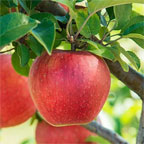- Q.Dill - I live in North FL and have started my dill from seed in small planting cells under light. The plants ...
- Q.Dill Weed Disease - Leaves on my dill weed plants are covered by some white residue which doesn't resemble mealybugs. It looks more of ...
- Q.Dill - What plants grow best next to dill?
- Q.Dill - Is dill an annual?
- Q.Dill Plant - How to plant - just read that I should have planted seeds.
- Q.All Around Fertilizer - Is osmocote for acid loving plants only? Is there a general plant food for all around fertilizing? I have Osocote ...
- Q.Dill - How do I harvest dill?
Q.Dill
I live in North FL and have started my dill from seed in small planting cells under light. The plants are now about 3" tall. I would like to know when it is appropriate to replant to the larger pots I intend on using.
- A.
If you are repotting into pots, you can move them once they have 2 true leaves/stems. You can wait until you feel comfortable handling them, but once they start growing real leaves (rather than the initial seedling leaves) they can be moved.
Was this answer useful?00
Q.Dill Weed Disease
Leaves on my dill weed plants are covered by some white residue which doesn't resemble mealybugs. It looks more of fungus nature. At that is what I think. I also noticed small white spots on stems as well lately. I have already tried different soaps and it didn't work. It is only present on dill plants and not on neighboring parsley, cilantro or chives. Please help. I have a lot of cucumbers and no dill.
- A.
Is it powdery in nature? If so, your plants have powdery mildew, which is a fungal issue and can be treated with neem oil. It is both an effective pesticide and fungicide, so it should take care of the issue regardless of whether or not it's a fungal problem or brought about by pests. Here is some additional information that will help determine if this is your problem and how to fix it: https://www.gardeningknowhow.com/plant-problems/disease/get-the-cure-for-powdery-mildew.htm, https://www.gardeningknowhow.com/problems/pests/neem-oil-uses.htm
Was this answer useful?00 Q.Dill
What plants grow best next to dill?
- A.
The following vegetables grow well with dill: broccoli, kale, Brussels sprouts, kohlrabi, asparagus, cabbage, and cauliflower. As for herbs and flower companions, dill can pretty much be grown near anything that shares its growing requirements; however, you may want to stay away from planting dill with carrots, Angelica, or caraway. Some good choices include cilantro and fern leaf lavender.
Was this answer useful?00 Q.Dill
Is dill an annual?
- A.
Actually it is a tender annual, and depending on where you live may be biennial. This plant will readily self-seed, especially in warmer climates. You can also collect seeds for replanting next season. For more information on growing dill, this article will help: https://www.gardeningknowhow.com/edible/herbs/dill/tips-on-how-to-grow-dill-weed-plants.htm
Was this answer useful?00 Q.dill plant
How to plant - just read that I should have planted seeds.
- A.
The general rule of thumb is that dill should not be transplanted since it has long taproots and may not fare well. However, if you do have a dill weed to transplant, here are some links that may help you:
https://www.youtube.com/watch?v=cSwDkqGtrpM
http://homeguides.sfgate.com/transplant-dill-31620.htmlFor information on how to grow dill weed from seed, please visit the following link:
https://www.gardeningknowhow.com/edible/herbs/dill/tips-on-how-to-grow-dill-weed-plants.htmWas this answer useful?00 Q.all around fertilizer
Is osmocote for acid loving plants only? Is there a general plant food for all around fertilizing? I have Osocote indoor/outdoor food you put in pots in granular form. I have herbs: dill, parsley, rosemary and cilantro. Also a succulent dish garden, geraniums, petunias, a mandevilla vine and vegetables in containers - Romaine, Swiss chard, strawberries. Everything is in containers with peat moss and gardening mix with vigirao except for geraniums I bought potted.
- A.
Osmocote can be used with the plants you mention.
I use a light fish emulsion in my herb and vegetable garden. It can be purchased at any garden center.
Here are some links for you.http://www.osmocote.co.za/FAQs.htm
https://www.gardeningknowhow.com/garden-how-to/soil-fertilizers/fish-emulsion-fertilizer.htm
Was this answer useful?00 Q.dill
How do I harvest dill?
- A.
This article should help: https://www.gardeningknowhow.com/edible/herbs/dill/drying-dill.htm
Was this answer useful?00



